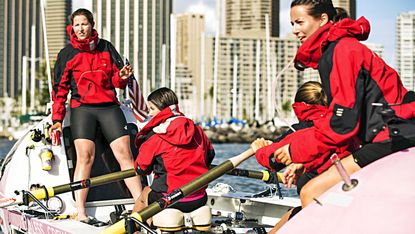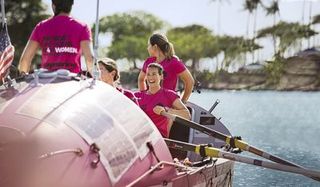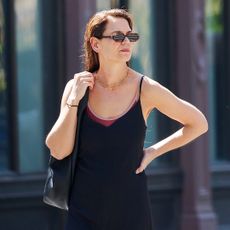
In April, Laura Penhaul and three other female rowers set off from San Francisco in a bubble-gum-pink, 29-foot carbon-fiber boat named Doris, bound for Australia. On the second day, the women got their first glimpse that this journey would be nothing like the practice rows in their native U.K.: Two humpback whales breached within yards of the boat, so close their barnacles were visible. The team's goal—besides up-close-and-personal encounters with marine life—is to row 8,446 miles to Cairns in about eight months and set three world records: the first all-female team to row across the Pacific, the first-ever four-person boat to do it, and the fastest-ever row across that ocean.
Though she's a marathoner and triathlete, Penhaul had never rowed until four years ago, when a friend told her about an opportunity to cross the Indian Ocean with an all-female team. She liked the prospect of pushing herself to the limit. As lead physiotherapist for the British Paralympic athletes, she wanted to better understand what her clients experience. "I'm fit and healthy—I'd never faced that adversity, something that's really asking you to challenge yourself," Penhaul explained from the crew's first stop in Honolulu. When that original Indian Ocean team didn't materialize, Penhaul wondered if it was possible to row the entire Pacific.

The 32-year-old team leader chose her teammates, all lifelong adventurers like her: Natalia Cohen, 40; Emma Mitchell, 30; and Isabel Burnham, 30. The preparation was grueling, with route planning, practice emergency rescues, hard-core training regimens, and a 48-hour sleep-deprivation row to test their physical and psychological health and their ability to work together as a team. Now that they're off, they row 24 hours a day in two-person, two-hour shifts, in up to 104-degree heat and 90 percent humidity. They eat freeze-dried spaghetti meals and sleep in the boat's two tiny cabins, each the size of a two-person tent. "When it's hot, it's like a two-person sauna," Cohen says. The cabins also hold all their supplies, among them hundreds of hand-packed food bags (dried mango is a favorite), emergency reserve water, and 20 liters of sunscreen. They have no other boat support, just two resupply stops, in Honolulu and Samoa. While they're docked, Lizanne Van Vuuren, 27, and Meg Dyos, 25, will rotate in to row the second and third legs for Burnham (all six women have taken leaves of absence from their jobs).
Now that they're off, they row 24 hours a day in two-person, two-hour shifts, in up to 104-degree heat and 90 percent humidity.
The team's first leg to Hawaii took 68 days, and included bouts of seasickness, sodden sleeping bags, 30-mile-an-hour winds, and storm waves the size of houses. The women sang songs, listened to music, blogged via satellite transmission, and watched for wildlife. They're also keeping video diaries for Emmy-winning filmmaker Sarah Moshman, who is making a documentary about the journey called Losing Sight of Shore.
If they make it as planned, they'll reach Australia in November or December. Even with their strict routine, they say there's plenty of time to take in the 360-degree views of sunrise and sunset. "It's easy to be completely, utterly in the moment," Cohen says. "In everyday life, it's hard. Here, we have all the time in the world."
[youtube ]https://www.youtube.com/watch?v=imqTdT556eE&feature=youtu.be[/youtube]
Track the team's journey and donate to their fundraising for charity at coxlesscrew.com.
Stay In The Know
Marie Claire email subscribers get intel on fashion and beauty trends, hot-off-the-press celebrity news, and more. Sign up here.
This article appears in the October issue of Marie Claire, on newsstands now.
-
 Trust Jennifer Lawrence: It's Mesh Flats Season
Trust Jennifer Lawrence: It's Mesh Flats SeasonIn some fashion circles, it never really ended.
By Halie LeSavage Published
-
 Bella Hadid's Lace Bustier Dress Deserves a Double Take
Bella Hadid's Lace Bustier Dress Deserves a Double TakeShe's heating up the lingerie dressing trend.
By Halie LeSavage Published
-
 Katie Holmes Is on a Minimalist Streak
Katie Holmes Is on a Minimalist StreakThe actress wore a slip dress with a '90s styling cue–plus her favorite Mary Janes.
By Halie LeSavage Published
-
 Senator Klobuchar: "Early Detection Saves Lives. It Saved Mine"
Senator Klobuchar: "Early Detection Saves Lives. It Saved Mine"Senator and breast cancer survivor Amy Klobuchar is encouraging women not to put off preventative care any longer.
By Senator Amy Klobuchar Published
-
 How Being a Plus-Size Nude Model Made Me Finally Love My Body
How Being a Plus-Size Nude Model Made Me Finally Love My BodyI'm plus size, but after I decided to pose nude for photos, I suddenly felt more body positive.
By Kelly Burch Published
-
 I'm an Egg Donor. Why Was It So Difficult for Me to Tell People That?
I'm an Egg Donor. Why Was It So Difficult for Me to Tell People That?Much like abortion, surrogacy, and IVF, becoming an egg donor was a reproductive choice that felt unfit for society’s standards of womanhood.
By Lauryn Chamberlain Published
-
 The 20 Best Probiotics to Keep Your Gut in Check
The 20 Best Probiotics to Keep Your Gut in CheckGut health = wealth.
By Julia Marzovilla Published
-
 Simone Biles Is Out of the Team Final at the Tokyo Olympics
Simone Biles Is Out of the Team Final at the Tokyo OlympicsShe withdrew from the event due to a medical issue, according to USA Gymnastics.
By Rachel Epstein Published
-
 The Truth About Thigh Gaps
The Truth About Thigh GapsWe're going to need you to stop right there.
By Kenny Thapoung Published
-
 3 Women On What It’s Like Living With An “Invisible” Condition
3 Women On What It’s Like Living With An “Invisible” ConditionDespite having no outward signs, they can be brutal on the body and the mind. Here’s how each woman deals with having illnesses others often don’t understand.
By Emily Shiffer Published
-
 The High Price of Living With Chronic Pain
The High Price of Living With Chronic PainThree women open up about how their conditions impact their bodies—and their wallets.
By Alice Oglethorpe Published